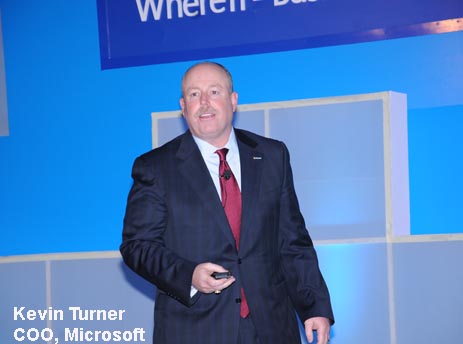
April 30, 2013: Kevin Turner, COO, Microsoft Corporation spoke at the Microsoft Executive Forum in Bangalore today to outline how the company planned on addressing the five key megatrends of the day.We bring you edited extracts of his remarks.
Boundaries for knowledge sharing/collaboration are blurring in new ways at a fast pace. It’s a transformative time for the IT industry and for Microsoft, a Devices and Services company with the primary focus of delivering devices and services that people love and businesses need.
Most industry experts acknowledge there are 5 megatrends – Cloud, Social, Mobile Big Data and Touch – that are shaping and transforming business and IT today and one can’t look at just one of them. They are all interrelated.
Cloud: Today, cloud is mainstream. It is the new normal today. Microsoft has a comprehensive cloud strategy that is enterprise grade as well as people focused. Some of the company’s offerings for cloud are: Office 365, Yammer, and Skype for productivity and collaboration; a database platform with SQL; and business applications with Dynamics CRM and Dynamics ERP.
The new Office revolutionizes productivity for people and businesses and is a significant innovation across the four core areas of Cloud, Social, Devices, and IT Control. Office 365 is now available in multiple countries and languages worldwide. Soon Lync 2013 users will be able to connect with anyone on Skype, unifying business communications. As more and more businesses, NGOs and people move to the cloud, it’s getting more government attention. Governments are working hard to balance the needs of businesses with regulations for cloud to ensure issues like security and cross border data flow are addressed.
Enterprise Social is all about enabling and empowering employees and partners to connect with the people they need to connect with, and to have the conversations that they need to have, to be more productive, get more done, and create more business value. The real power of enterprise social is when you can connect your employees and partners with customers and more than 85 percent of Fortune 500 companies have already begun deploying social solutions. Microsoft has created the hooks in the New Office to make tools more social, both internally and externally, so that people can draw on their broader networks – Facebook, Twitter and LinkedIn. And with Yammer, social engagement and collaboration can be taken to a whole new level.
Mobility: Microsoft has solutions to help businesses manage BYOD (Bring Your Own Device), both on-premise and in the cloud. Microsoft helps enable the IT manage end users’ devices “in the world that they live in.” Microsoft Office is available across mobile platforms but the best Office mobile experience is on Windows Phone 8, with the Office hub. Office Web Apps for Word, Excel, PowerPoint, and OneNote enable high-fidelity document viewing on iPhone, and viewing and some editing on iPad. On Android, Office Web Apps are available for viewing and some editing.
Big Data: Big data is everywhere. It has the potential to change the way governments and organizations conduct business and make discoveries. Microsoft is on a path to manage all types of data in both the public cloud and on-premise – no one else can say this. Microsoft’s big data offerings include: Horton Data Platform (HDP) on Windows – Windows Server with Hadoop; SQL Server 2012 Parallel Data Warehouse v2; Windows Azure HD Insight Service; and Microsoft HDInsight Server for Windows.
Touch: Microsoft is moving its entire ecosystem to touch. This won’t happen overnight but it already has strong momentum. 1.5-billion people in the world use Windows today and Windows 8 brings touch to the masses. Not only that, Windows 8 brings touch to all form factors with the Surface tablet, laptops and PCs. Microsoft has more than doubled the number of Windows 8 devices since October 2012. There are more and more certified systems for Windows 8 and RT every single day with more on the way.
After a robust, extended lifecycle, Microsoft is phasing out support for Windows XP. Microsoft’s support – which means the end of security updates, (paid) hotfix agreement support, and paid per-incident support services – for Windows XP will stop from April 2014.Microsoft will invest $10.1 billion in R&D across the five megatrends. In 2012, Microsoft spent over $9.5 billion in R&D which was more than its nearest competitor. Microsoft has sustained its investment in product development and innovation year over year and continues to do so.
Microsoft believes the role of the CIO is changing today and an understanding of the 5 megatrends and the ability to move quickly to implement strategies around them will what make one a valuable CIO today.